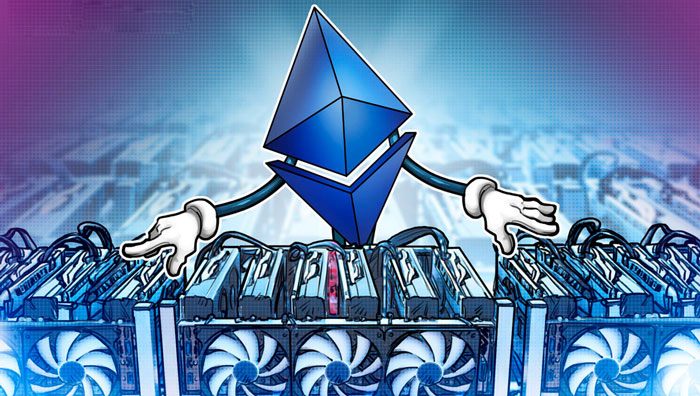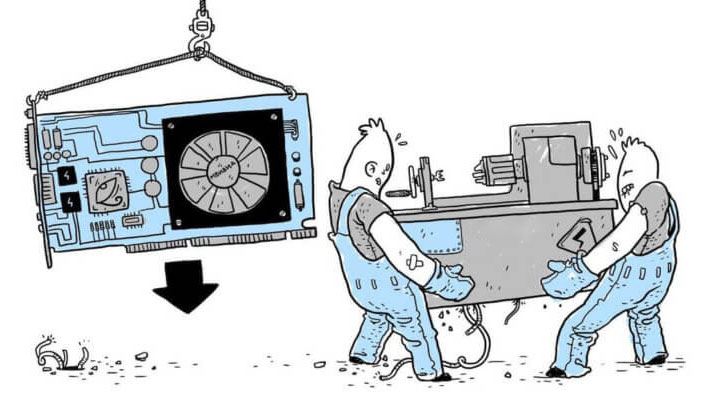
The issue of activating the controversial ProgPoW algorithm on the Ethereum network has not been raised for almost a year. However, on February 21unexpectedly for everyone, kernel developersEthereum announced that ProgPoW will be implemented on the network in July. The news caused a new wave of indignation among opponents of the activation of the algorithm. They believe that its implementation will not solve Ethereum’s problems, but may lead to a split in the network.
Opponents of ProgPoW created a petition on GitHub, calling to stop the implementation of the algorithm in the next update of Ethereum. The appeal has already been signed by dozens of prominent members of the Ethereum community.
What arguments do opponents of implementation bringProgPoW, do they support an alternative option for switching to Proof-of-Stake and how ProgPow will affect the DeFi sector, Mining-Cryptocurrency.ru figured out.
Why is Ethereum updated?
The main problem of Ethereum is scalability:the network is overcrowded, running at full capacity, transactions are slower and slower, and the cost of “gas” (transaction fees) is rising. If you don't change anything, sooner or later the network will become almost impossible to use.
In order to keep up with those catching up, technically moreperfect competitors, the developers have been working for several years on the transition of the network from the PoW algorithm to the Ethereum 2.0 state, running on PoS. This should make the network more scalable, faster and cheaper.
On December 8, the first stage of the long-awaited Istanbul update was implemented on the network, which reduced gas costs, made Zcash compatible with Ethereum and protected the network from duplicate transactions.
The next Berlin update should happen inmid-June. It includes proposals for activating the ProgPoW algorithm (EIP 1057), changing the cost of gas (EIP 1380, EIP 2045, EIP 2046) and optimizing the operation of the Ethereum virtual machine (EIP 1985).
ProgPoW - Transitional Time Algorithm
Programmatic Proof-Of-Work (software proof of work, ProgPoW) is a version of the PoW algorithm that should smooth the transition of the Ethereum network to the PoS algorithm.
The main reason for the development of ProgPoW is the impactwhich ASIC miners and manufacturers are impacting the crypto industry. Large manufacturers like Bitmain and Innosilicon monopolized the market with their devices. After Bitmain’s Antminer E3 entered the market in April 2018, the share of GPU miners began to steadily decline - they suffered losses and lost interest in maintaining the network. As a result, the network becomes more centralized and therefore less secure.
ProgPoW - an unusual mining algorithm, itDesigned specifically for GPU devices (video cards). The protocol constantly changes the condition of the task. However, ASIC miners are designed to solve one specialized task. With a constant change in the task parameters, their effectiveness decreases, and the advantage over GPU devices that can perform many tasks is reduced to nothing. As a result, ProgPoW allows you to mine on GPU devices as efficiently as on ASIC miners.

It is assumed that the leveling of benefitsASIC miners will make the Ethereum mining infrastructure more decentralized, which in turn will increase the chances that the upgrade will go smoothly and a new network split will not happen. It should also protect the Ethereum network from the monopoly of ASIC hardware manufacturers, make it more stable, make new coins more accessible, and stop the miners' race for power.
ProgPoW activate in July 2020
For the first time, a proposal to activate ProgPoW (EIP)1057) was proposed in May 2018. At the beginning of 2019, it was approved subject to a code audit. The lack of clear consensus last March led to a vote among community members who overwhelmingly supported the proposal.
However, after last SeptemberProgPow was declared safe and nothing was heard from it for six months. The developers have officially stated that they are still looking for an opportunity to activate ProgPoW as a separate hard fork. Part of the community clearly hoped that the idea would reach a dead end and that it would not be remembered.
But on February 21, Ethereum core developerspreviously re-approved the activation of the new algorithm. ProgPoW is not backwards compatible with the current network algorithm, Ethash. Therefore, it will be implemented as part of a separate hard fork. The date is set for July this year - three weeks after the scheduled activation of the Berlin update in June.
Why is the community against activating ProgPoW?
Around the implementation of ProgPoW serious controversy immediately flared up.
Initially overwhelmingthe majority were opponents of renewal. However, gradually the community's opinion changed to the opposite. Currently, most members of the Ethereum community and all pools support the implementation of ProgPoW.
But I’m still against the idea of implementing ProgPoWSeveral dozen prominent Ethereum developers speak, including Phil Dayan, Martin Keppelman, Amin Soleimani, Georgios Konstantopoulos, James Prestwich and Scott Lewis. They believe that the implementation of the algorithm will not achieve the desired goals - mining will still remain concentrated in farms and pools, and miners will lose part of their income. ASIC devices have many advantages over GPU processors: they make the network safer and faster, and there is no direct evidence that they cause excessive centralization.
I am against a #progPOW hardfork.
To me there are only two legitimate reasons to hard fork Ethereum.
1) Address an existential threat
2) Bring Ethereum one step closer to a long-term sustainable stable state#progPOW is tinkering in favor of one group (GPU miners) vs another.- Martin Köppelmann (@koeppelmann) January 6, 2019
“I am against the hard fork ProgPoW. For me, there are only two legitimate reasons for the Ethereum hard fork: 1 - eliminate the existential threat; 2 - one step closer to Ethereum long-term stable stable state. ProgPoW works only in favor of one group (GPU miners), ignoring the interests of another ”, - Gnosis founder Martin Keppelmann explained the reasons for his rejection of the algorithm.
I am against a #progPOW hardfork.
To me there are only two legitimate reasons to hard fork Ethereum.
1) Address an existential threat
2) Bring Ethereum one step closer to a long-term sustainable stable state#progPOW is tinkering in favor of one group (GPU miners) vs another.- Martin Köppelmann (@koeppelmann) January 6, 2019
“ProgPoW is not one group of miners against another. ProgPoW is a strategy that limits performance gains in various types of equipment, helping to further hash decentralization ”, Said Keppelmann, a Twitter user.
Plus, ProgPoW won't stop manufacturersASIC devices - they will soon begin to produce new equipment capable of running on it. This, by the way, is confirmed by an audit of hardware and software for ProgPoW conducted by Ethereum Cat Herders.
The audit results showed that the protocol iseffective, but can quickly become obsolete - it really reduces the advantages of ASIC miners to a minimum, but manufacturers will soon be able to release more advanced chips, bypass the algorithm's limitations and start ASIC mining on the network again.
I am down to change my mind and support ProgPoWif someone could please help me understand why and how ASIC miners will attack the Ethereum PoW chain. So far most fears seem irrational and unfounded, but I am willing to be convinced otherwise.
- Viktor Bunin (@ViktorBunin) February 25, 2020
“I am ready to change my mind and supportProgPoW, if someone can help me understand why and how ASIC miners will attack the Ethereum network on PoW. Until now, most fears seem irrational and unfounded, but I’m ready to believe otherwise. ”- writes Bison Trails developer Victor Bunin.
Opponents of ProgPoW also admit the existencestrategic alliance and deliberate promotion of the algorithm to achieve one's own benefit. There is a theory, not directly confirmed, that NVIDIA funded the team responsible for developing ProgPoW to give owners of Nvidia graphics cards an advantage over users of AMD devices.
The main thing is that opponents of ProgPoW are not sure aboutthe need for such a radical upgrade. In their opinion, the algorithm is not the primary task for the development of Ethereum. The controversy surrounding ProgPoW only distracts the developers and the community from the development of the network - Ethereum still switches to the PoS algorithm, and additional discussion can lead to a network split.
What are petition signers calling for?
Author of a petition against ProgPoW published 26February on GitHub, - Justin Leroux from ETHBoston. In his address, he basically repeated the arguments of opponents of the implementation of the algorithm, emphasizing that its implementation could be a reason for a split in the community. He considers his appeal "a signal for the community and the main developers that a wide coalition of experts and key participants in the Ethereum community is strongly against activating ProgPoW on the ETN network ”. The author calls on all those who disagree with the implementation of the protocol to join the petition.
The appeal was signed by over 70 people - prominentindustry people. Among them, Hayden Adams is the CEO and founder of the Uniswap exchange protocol, Tim Coulter is the CEO of the Truffle Suite smart contract platform, Andrew Case is the co-founder of the DARMA Capital investment company, as well as representatives of EthereumDC, Aragon, MolochDAO, Gnosis, DeFi Pulse, MakerDAO, Synthetix, Gnosis, ConsenSys, DeFi Pulse and others.
Leroux notes that not everyone supports the update.
"Since Ethereum is globalplatform with a large and diverse group of stakeholders, it is critical that major changes to the protocol have a clear purpose and broad support. EIP 1057 clearly lacks such support, however, its activation is being considered", Said the petition.
ProgPoW supporters believe integrationThe algorithm is able to prevent the hard fork that can occur on the network a few months before switching to PoS. Leroux tells them that the exact opposite can happen - the activation of ProgPoW “increases the likelihood of this unwanted result", EIP 1057 only reinforced the discussion of community sharing.
Ethereum community could not reach consensusabout the implementation of ProgPoW after two years of controversy, which left the forces of developers. A “forced” implementation of the protocol would only exacerbate the emerging split in the community.
Poll of the day: Should Ethereum hard-fork (ProgPOW) to disrupt ASICS, for the benefit of GPU miners? Is it worth the risk of splitting the chain / community, at this point in the game, to uphold decentralized mining?
- Omar Bham (Crypt0) (@ crypt0snews) February 22, 2020
"Poll of the day: should Ethereum hard fork on ProgPOW infringe on ASIC miners, in the interests of miners on GPU devices? Is it worth it now to risk the separation of the network / community to support decentralized mining? ”, - crypto blogger Omar Bhan asked his subscribers. Most opposed.
Leroux writes that Ethereum already has ways,which will help ensure a smoother transition from PoW to PoS. For example, activation of the “complexity bomb” - an increase in network complexity every 100,000 blocks, designed to encourage miners to switch to PoS.
Ethereum is already preparing for the difficult transition from PoW to PoS. The introduction of ProgPoW before this is additional technical risks and distraction of attention from really important things.
Leroux notes that some experts believe thatProgPoW does not offer any obvious advantages - there is no clear evidence that the protocol serves its original purpose - to deprive ASIC miners of their advantages (apparently ignoring the findings of the Ethereum Cat Herders audit).
One of the signatories of the petition, co-founder of the analytical and rating agency DeFi Pulse Scott Lewis, in a comment to The Block, noted that “among ordinary members of the Ethereum community, the prevailing opinion is that ProgPoW should not be launched". If the majority’s opinion does not influence the way Ethereum develops, the network management process should change, Lewis believes.
Ethereum co-founder VitalikButerin has distanced himself from the development of Ethereum 2.0 - he believes that this way the project is more decentralized. Previously, he was critical of the ProgPoW update, believing that it only distracted attention. This time he criticized the developers for making a decision unilaterally - this undermines the trust of the community.Buterin proposed developing a new procedure for reviewing controversial decisions about the future of the network, but noted that he was neutral about ProgPoW itself.
Because if we don’t erect psycho-sociological walls in the form of norms saying where we clearly don’t want governance to go, people who distrust the governance will feel unsafe.
- vitalik.eth (@VitalikButerin) February 24, 2020
"The way the decision was made to activateProgPoW definitely didn’t help people trust developers anymore or feel safe, and perhaps made Twitter users believe that they should speak out loud, simple and clear ... so that their voice is heard ”, - Vitalik Buterin wrote on his Twitter.
Will activation of ProgPoW lead to a network split?
Recall that disagreement with the network upgrade has already led Ethereum to a split - so in October 2016, Ethereum Classic was born. What are the chances that this will happen again?
The main catch is that plans are not yet cleardevelopers after activating ProgPoW. It is assumed that after the launch of Ethereum 2.0 on PoS, the current version of the network will continue to work for a couple of years. There is a great risk of getting the Ethereum 1.0 community on ProgPoW and Ethereum 2.0 on PoS. There is really no guarantee that this will not happen.
Also, a lot will depend on the actions of miners- will they support the transition. They have every reason to resist the transition to PoS - it will deprive them of a source of income. For them, ProgPoW is more profitable than PoS.
ProgPoW should unite the Ethereum communityin the face of a controversial update. But the problem is that this algorithm itself is a controversial update. As Eric Conner, an employee at Gnosis, noted, when making decisions about code implementation, it is wrong to think along the lines of “well, only 30% of the community is against - this is not enough for fork". On the contrary, the idea needs to be discussed a lot and if there is at least some chance of a network split, this idea must die.
Out of curiosity — if it appears that you’re in a minority and most of the network upgrades to ProgPoW are you going to follow or quit Ethereum at all (or switch to ETC for example)?
- Krzysztof Urbański (kaereste.eth) (@kaereste) February 23, 2020
“Well, if we get to this point [whenmost of the community will support ProgPoW], I will sell my ETH. Activating the algorithm will damage the value of the network, and I'm not going to be an idiot who supports the community’s struggle or its split. I will save my eth1 node in a chain without ProgPoW and think about joining the network only after eth2 lives on ”, - Gnosis developer wrote on Twitter.
However, we think that now, despitethe disagreement of many members of the community, a network split is unlikely. For all the controversy, ProgPoW is the most elaborate and ready to activate offer, which is supported by the main developers of the project and all pools.
Even opponents of the algorithm are primarily afraid of a network split - most likely, even if they disagree with the activation of ProgPoW, they will not follow any calls for separation.
DeFi can prevent chain breaking
DeFi Pulse founder Scott Lewis in the commentsDecrypt noted that controversial hard forks are no longer a reasonable dispute resolution tool for Ethereum governance decisions - the consequences for the ecosystem may be too severe. This will impact the DeFi ecosystem the most.
Nobody is making a strong case why we * need * ProgPoW.
I get that some people *want* it but it’s not worth the goddamn chain split risk, ok?
? DeFi can’t afford a contentious chain split. ?
Nearly $1b is at stake here.
Can we stop f ** king around with this now? Please?
- Chris Blec (@ChrisBlec) February 26, 2020
“No one can clearly explain why we needProgPoW. I understand that some people want this, but is it really worth the risk of a network split? DeFi cannot afford a controversial fork - almost $ 1 billion is at stake. Can we stop this damn thing and what's happening around it now? What do you think?"— Blockchain blogger Chris Black asks his followers.
A similar point of view is shared by an independentblockchain researcher Leland Lee. In his article “Ethereum is no longer afraid of forks, thanks to DeFi for that,” he writes that due to the fragility of DeFi, Ethereum will no longer have a significant fork.
Decentralized finance ecosystem tootangled up to allow a chain split. If some projects choose a new chain while others remain in the old one, this will destroy the entire system - no one will allow it. Lee suggested that if important players in the DeFi space oppose ProgPow, many DeFi operators will follow suit.
Ethereum is now far from a situation that inThe result led to a split in the network in 2016. All major applications run on DeFi, which makes the ecosystem fundamental in deciding on the future of the network. And now it seems that most of the DeFi projects are against ProgPow.
Finally
Whatever decision to activate ProgPoW is madeEthereum developers, it will be controversial, and the implementation of the algorithm is unlikely to go perfectly smoothly. If the fork of the network is still not threatened, and the increase in disputes on Twitter is the maximum negative consequences, then the only way to stop this protracted dispute will finally activate the algorithm.
Do you support the implementation of ProgPoW on the Ethereum network? Share your opinion in the comments below!
</p>Rate this publication





